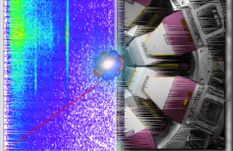1#define ExampleTreeSelector_cxx
8 fTree[
"coinc"] =
new TTree(
"coinc",
"coincident events");
9 fTree[
"timebg"] =
new TTree(
"timebg",
"time random events");
16 fTree[
"coinc"]->Branch(
"entry", &
fEntry,
"entry/L");
20 fTree[
"timebg"]->Branch(
"entry", &
fEntry,
"entry/L");
23 fH1[
"asE"] =
new TH1D(
"asE",
"suppressed Addback Singles", 12000, 0, 3000);
24 fH2[
"sceptarMult"] =
new TH2D(
"sceptarMult",
"Sceptar multiplicity vs. Griffin multiplicity", 64, 0, 64, 40, 0, 40);
25 fH2[
"zdsMult"] =
new TH2D(
"zdsMult",
"ZeroDegree multiplicity vs. Griffin multiplicity", 64, 0, 64, 10, 0, 10);
34 for(
auto it :
fTree) {
73 fH1.at(
"asE")->Fill(grif1->GetEnergy());
82 bool foundBeta =
false;
118 fTree.at(
"coinc")->Fill();
120 fTree.at(
"timebg")->Fill();
bool PromptCoincidence(TGriffinHit *one, TGriffinHit *two)
bool PromptCoincidence(TGriffinHit *g, TZeroDegreeHit *z)
TSceptar * fScep
pointer for sceptar branch
std::vector< double > fSuppressedAddback
vector of suppressed addback energies
TGriffinBgo * fGriffinBgo
pointer for griffin BGO branch
std::vector< double > fBetaGammaTiming
vector of beta-gamma timing
TZeroDegree * fZds
pointer for ZDS branch
TGriffin * fGrif
pointer for griffin branch
virtual Double_t GetTime(const ETimeFlag &correct_flag=ETimeFlag::kAll, Option_t *opt="") const
Returns a time value to the nearest nanosecond!
virtual Short_t GetMultiplicity() const
TGRSIMap< std::string, TH1 * > fH1
TGRSIMap< std::string, TH2 * > fH2
TList * GetOutputList() const override
this does the same as TSelector::GetOutputList()
TGRSIMap< std::string, TTree * > fTree
TGriffinHit * GetSuppressedAddbackHit(const int &i)
Short_t GetSuppressedAddbackMultiplicity(const TBgo *bgo)
TSceptarHit * GetSceptarHit(const int &i) const
TZeroDegreeHit * GetZeroDegreeHit(const int &i) const



